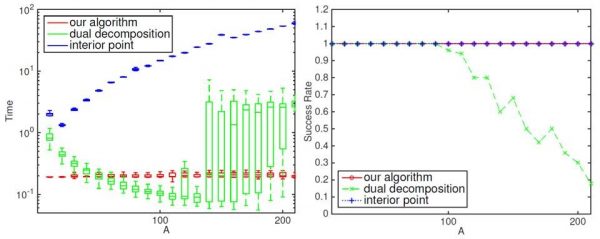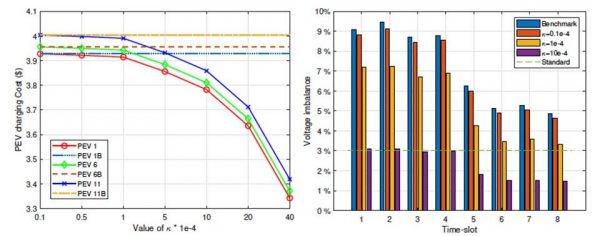The increasing uptake of electric vehicles and data centers across many developed and developing societies has created additional pressure on electrical grids across cities. The implementation of smart grids improves the efficiency of the electricity system by accounting for the ebb and flow of commercial, industrial, and residential electricity demands.
In recent months, Professor Yang Zaiyue from the Department of Mechanical and Energy Engineering (MEE) at Southern University of Science and Technology (SUSTech) has led his team to make vital breakthroughs in the integration of smart grids, data centers, and electric vehicles, based on novel techniques in optimization, game theory and machine learning. His team has published papers in IEEE Transactions on Smart Grid and IEEE Transactions on Power Systems, while also presented a paper at the 32nd Neural Information Processing Systems Conference.
The paper in IEEE Transactions on Smart Grid (IF = 10.486) examined the optimal management of large-scale electric equipment. “A Fast Algorithm for Optimal Power Scheduling of Large-Scale Appliances with Temporally-Spatially Coupled Constraints,” was the title of the article.
The optimal management of electrical equipment is vital for smart grid demand response. The basic problem hinges on the need to manage the demand for a significant volume of electrical appliances and multiple time slots simultaneously. The time-space coupling is very difficult to solve in a short period, hence the need for an algorithm that improves the efficiency of the calculation.
The team grounded their algorithm on the Karush-Kuhn-Tucker (KKT) condition of optimization theory. The KKT condition reduces the number of variable dimensions to improve the efficiency of the calculation by going through fewer steps and reaching the appropriate convergence point faster.
 Figure 1 left: algorithm calculation speed; right: algorithm success rate
Figure 1 left: algorithm calculation speed; right: algorithm success rate
Professor Yang Zaiyue is the corresponding author of this work. Dr. Guo Zhenwei from the State Key Laboratory of Industrial Control Technology at Zheijiang University was the first author. Other contributing authors included MEE Research Assistant Professor Chen Shibo, Beijing Sport University School of Sports Engineering Professor Liu Haoyang, and State Key Laboratory of Industrial Control Technology Dr. Yang Qinmin.
The research received support and funding from the National Science Foundation of China (NSFC), the Shenzhen Committee on Science and Innovation, the Guangdong Provincial Department of Science and Technology, and the Guangdong Province Key R&D Program.
Article link: https://ieeexplore.ieee.org/abstract/document/8784421
The second paper in IEEE Transactions on Smart Grid studied the ideal method to reduce the power cost of cloud service providers. It considers the influence of cloud service providers operating multiple data centers within a single power market while maintaining the ability to move data workloads between different data centers. “Workload transfer strategy of urban neighboring data centers with market power in local electricity market” was the name of the paper.
Cloud service providers use a significant amount of electricity as part of their operations, so transferring power load can affect the marginal price of electricity at individual sites. The research group of Professor Yang Zaiyue took a two-tier approach to the problem when exploring the task transfer strategy of minimizing operating costs. They separated the minimization of operating costs (upper-tier) from the determination of electricity prices (lower tier).
Solving a two-tier problem is highly challenging, so the research group opted to rebuild it into a single-tier problem. The feasible region of the problem was proved to be a non-convex polyhedron, and the problem was solved under a proposed polyhedron cutting algorithm.
The research analyzed the impact of transfer price uncertainty on the cost for cloud service providers. Increased uncertainty reduces total expected costs without an accompanying shift in the expected cost of communications.
The simulation of the proposed algorithm, tested under IEEE standardized cases, showed that cloud service providers’ costs drop significantly while both electricity providers and cloud service providers can both benefit from the algorithm. This price maker model can reduce the price difference and increase the efficiency in resource allocation.

Figure 2 left: locational marginal price; middle: data center task processing capacity; right: generator generation capacity.
Professor Yang Zaiyue is the corresponding author of this work. The main units of this work were SUSTech, the College of Control Science and Engineering at Zhejiang University (ZJU), the School of Data Science at the City University of Hong Kong (CityU), and Beijing Sport University. The research received funding and support from the National Science Foundation of China (NSFC), the Shenzhen Committee on Science and Innovation, the Guangdong Provincial Department of Science and Technology, the Guangdong Province Key R&D Program, and the Zhejiang Province Key R&D Program.
Article link: https://ieeexplore.ieee.org/document/8963651
The other paper was published in IEEE Transactions on Power Systems (IF = 6.807) assessed the use of incentives to bring electric vehicles into the power grid. “A Game Theoretic Approach to Phase Balancing by Plug-in Electric Vehicles in the Smart Grid,” was the title of the published paper.
There has been significant research on how to integrate new energy generation into the power system. The development of new energy has aggravated the problem of phase imbalance, as solar energy and other forms of new energy do not provide a consistent flow of energy over extended periods. Their inconsistency and randomness make traditional manual phase switching methodologies somewhat redundant.
The research group of Professor Yang Zaiyue took a different approach by examining the economic concept of incentives to encourage electric vehicle users to vary their charging times. Such flexibility would assist in balancing the electrical grid, thereby ensuring its safety and stability.
Game theory was applied to find an optimal intersection between the lowest charging cost and the largest compensation for phase balance (with the broad premise of satisfying demand for electricity). A non-cooperative game was used to model different electric vehicles, but this failed to provide effective analysis. The group opted for an extended game to find the Nash equilibria before proposing a distributed algorithm to solve for these different equilibria. Their simulation (using IEEE standardized test cases) showed that a well-designed incentive strategy would reduce electric vehicle charging costs while also reducing phase imbalances in the electricity grid.

Figure 3 left: electric vehicle charging cost; right: power grid phase imbalance.
Professor Yang Zaiyue is the corresponding author of this work. The first author was MEE Research Assistant Professor Chen Shibo, with additional support from Dr. Guo Zhenwei from the State Key Laboratory of Industrial Control Technology at Zheijiang University, Assistant Professor Xu Yunjian from the Department of Mechanical and Automation Engineering at Chinese University of Hong Kong (CUHK) and Professor Roger Shu Kwan Cheng from the Department of Electronic and Computer Engineering at Hong Kong University of Science and Technology (HKUST).
The research received support and funding from the National Science Foundation of China (NSFC), the Shenzhen Committee on Science and Innovation, the Guangdong Provincial Department of Science and Technology, the Guangdong Province Key R&D Program, and the Zhejiang Province Key R&D Program.
Article link: https://ieeexplore.ieee.org/abstract/document/8862870
In December 2019, Professor Yang Zaiyue presented at the 32nd Neural Information Processing Systems Conference (NIPS 2019). NIPS 2019 is an annual conference in machine learning. He presented an international collaboration titled, “Communication-Efficient Distributed Learning via Lazily Aggregated Quantized Gradients.”
Current models for machine learning use a significant number of mobile devices to collect data, raising questions about the financial and privacy costs of this centralized training. Thus, a consensus has formed around the optimal method of distributed learning. An increase in the number of devices can increase costs when distributed learning operates within a server-centered system (known as the server-worker mode). Server-worker mode allows devices to receive new information and updated learning parameters without requesting old information. It also eliminates privacy concerns while reducing the burden on the server. There is a significant increase in a wider set of costs for deep learning. Any delays in communications create a larger bottleneck and prevent the full utilization of distributed computing resources for machine learning.
The paper hypothesized the use of information compression and adaptive communication for distributed machine learning by applying a basic gradient descent algorithm (for example, transmitting data with 4 bits instead of 32 or 64 bits). The proposed algorithm designed by the team showed rapid convergence and significantly reduced data transmission during communication. Their simulations showed that their algorithm converged and communicated faster while using less data (bits) in transmission compared to existing algorithms.

Figure 4
The first authors were Dr. Sun Jun (ZJU) and Assistant Professor Chen Tianyi (Rensselaer Polytechnic Institute Department of Electrical, Computer, and Systems Engineering). Chair Professor Georgios B. Giannakis (University of Minnesota, Twin Cities Department of Electrical and Computer Engineering) and Yang Zaiyue (SUSTech) were the correspondent authors.
The paper received support from the Shenzhen Committee on Science and Innovations, the Department of Science and Technology of Guangdong Province, the Natural Science Foundation of China, the China Scholarship Council, and the National Science Foundation (NSF).
Article link: http://papers.nips.cc/paper/8598-communication-efficient-distributed-learning-via-lazily-aggregated-quantified-grades
Proofread ByXia Yingying
Photo ByDepartment of Mechanical and Energy Engineering